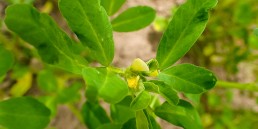Herbal Actions
What is a “herbal action”?
When we speak about the action(s) of a certain plant, we are referring to one or more effects a plant can have on our body. Often these actions are explained in two or three words; however, herbal actions are so much more than that! Since plants are wonderful complex beings, they also have several actions. Most herbs can compliment their action(s) in combination with another herb, basically showing off their best side with the support of a “good friend”. Sometimes they work great on their own, but most of the times, they excel with a good buddy on their side. Think- Teamwork!
Bitters
In our modern “western” diet, there are only a handful of bitters that have established themselves into restaurants and home kitchens. But then, most of the time, the natural bitter taste of these power foods is reduced by for example sprinkling sugar on a grapefruit or by offering caramelized Brussel sprouts instead of experiencing the real deal. How about a good, bitter coffee? Well, most decide to add a big load of sugar into their dark brew… It almost seems like the naturally occurring bitter taste has become the enemy.
How did we get there? Considering the endless health benefits of bitter plants and foods, why do we try to either mask them or associate them with something bad?
Where our ancestors diet mainly consisted of foraged foods, including lots of bitters, it seems that our modern culture has been taught to like sweets, and dislike bitters. A lot of times when we taste something bitter, we think “Eww! That’s so gross!”. But how about don’t engage in this kind of thinking; how about we go “Wow! That is so POWERFUL!!” Because that is exactly what it is! It is within our power to take away that judgement and re-train our brain. Do you want to join? Let’s try something.
A very wise and experienced herbalist once shared with me how to get my kids to like/ be okay with bitters – lucky for everyone, this technique also works extremely well for grown ups. Yay!! Ready?? Go outside and pick either a dandelion leaf (a mild bitter) or, for a stronger bitter experience, pick some Yarrow or Mugwort. After a nod of gratitude and making sure it does not come from a sprayed lawn or has seen frequent pet-traffic, go ahead and nibble on it. Now try to experience the following:
Phase 1 – Brain response: Our body notices we are chewing on something bitter – Think: WOW!! This has power!
Phase 2 – Contraction: Now it is time to surrender; let your body feel this power and do not fight it or hold the contraction. How does it make you feel?
Phase 3 – Relaxation: After the initial “power-shock”, can you feel how your system is relaxing? Can you feel how your digestive tract is responding; producing a pleasant warming feel in your stomach? Can you feel how your gut-brain connection is not just helping to relax your gut, but also your nervous system?
BITTERS FOR POWER!!
Try this with many different bitter tastes and gradually increase them in your diet. It is also super beneficial to get into the habit of taking bitters just before a meal. But more on that in a little bit…
But, How Bitter is Bitter?
Sometimes you can find a number referring to how bitter a plant is. The number of 1000 for instance describes that 1g of the plant substance can still be experienced as bitter in 1000ml of water.
To get an idea of how bitter some plants are, let me share a few of these bitter numbers:
| Taraxacum officinalis (Dandelion) | 100 |
| Orange Peel | 600 |
| Alchiella millefolium (Yarrow) | 3.000 – 5.000 |
| Artemisia vulgaris (Mugwort) | 10.000 – 20.000 |
| Artemisia absinthium (Wormwood) | 10.000 – 30.000 |
| Gentiana lutea (Gentian) | 10.000 – 30.000 |
A bitter herb like Wormwood tastes so bitter and bile-like, that you cannot simply “wash it down” with a cup of water or something even stronger. Its bitterness is so intense that it can be felt in both your mouth and esophagus for an hour or more afterwards.
How Bitters Work
Bitters can have positive effects on many body systems. In this post I will be focusing on the bitter action on the digestive tract.
As the traditional German saying has it: “Was bitter im Mund, ist dem Magen gesund” – ‘What’s bitter on the tongue is healthy for the stomach’.
Interestingly, bitter taste receptors are not only found in the mouth, but also in the respiratory tract, the liver, the GI-tract, parts of the urogenital tract and other places in the body.
Bitters are intense communicators; when tasted by the tongue, they literally demand attention and provoke a response. The first response happens right away in the mouth as the salivary enzymes get ready for action and salivation increases. Saliva moistens the food and contains enzymes like amylase and lingual lipase. Amylase breaks down starches into sugars for easier absorbed by the body, and lingual lipase kickstarts the break down of fats.
Besides the increase of salivary secretions, messages are sent to the digestive system, signaling the release of the digestive hormone gastrin. Peristalsis, the wavelike motion of the digestive system that stimulates the motility of food along the digestive tract is prompted as well. The digestive tract is encouraged to start properly breaking down food and ensuring optimal absorption of nutrients.
Among Many Other Actions, Bitters:
- Trigger digestive functions
- Stimulate the release of digestive juices
- Increase the flow of bile
- Aid the liver in detoxification work
- Promote intestinal motility
- Are tonifying
- Stimulate appetite
Using Bitters and Preparations
Many herbalists suggest using bitters in form of a tincture. Especially for digestive uses, bitters should really be tasted. A lovely herbalist friend of mine once suggested putting them into a small spray bottle for easier use. This excellent technique makes it really easy and convenient to “quickly” take your bitters.
Otherwise, befriend the powerful bitters and add as many as you can to your regular diet. Start slowly and increase the addition of bitters and reduction of sweetness.
Alternatively, any bitter can also be taken in the form of a tea as gentle decoction. As many bitters also contain aromatic compounds, keep the lid on while decocting and carefully add the accumulated drips on the lid back into your brew. A bitter tea, however, may not be your first choice if you are new to the bitter taste.
Those Who Should Avoid Bitters – Contraindications:
Pregnant women may want to stick to very mild bitters as stronger bitter can potentially cause cramping. Before taking bitters, contact a professional herbalist if you are experiencing heart burn or gastroesophageal reflux disease. They will be able to help you determine if bitters are going to be helpful or possibly worsen the situation. A further contradiction from bitters is if one is suffering from kidney or gallstones. For those with a generally cool/dry constitution, add some warming spices (like ginger or thyme) to counter the generally cooling energetics of bitters.
Examples of Some Bitter Herbs
Lovely bitter herbs to support the digestive tract include;
- Rumex crispus (Yellow dock)
- Gentiana lutea (Gentian)
- Taraxacum officinalis (Dandelion)
- Artemisa vulgaris (Mugwort)
- Matricaria recutita (Chamomile)
I hope this post gave you a little insight on Bitters and how they can interact with our body. This topic is covered much more in depth in the herbal course, which is currently developed and coming soon by our group of wonderful herbalists.
Resources:
Besides my own words, this write up features information from the following resources:
– Ursel Buehring Praxis- Lehrbuch Heilpflanzenkunde – Grundlagen – Anwendung – Therapie. 4 ueberarbeitete Auflage. Karl F. Haug Verlag in MVS Medizinverlage Stuttgart GmbH & Co. KG’ 70469 Stuttgart, Germany. 2014. (Published in German language)
– Jim McDonald – Foundational Herbcraft – www.herbcradft.org – collected writings from www.PlantHealkerMagazine.com.
– David Hoffmann – Medicinal Herbalism: The science and practice of herbal medicine. Healing Art Press, Rochester, Vermont 05767. 2003.
– Lisa Ganora – Understanding Herbal Constituents and Plant Chemistry (2007)
Evelyn Mueller
I am a community herbalist based in Ontario, Canada, and a graduate of The Ginkgo Tree Herbal Course and founder and creator of ‘The Lion’s Tooth’: a 12 month program to help families re-connect with nature and use plants like their ancestors did. It is my mission to share the wonders nature provides for us, to establish meaningful relationships between humans and plants as well as to help awaken our embedded instincts and use those to nurture and heal our body, our mind and our wonderful earth.
Subscribe to Blog via Email



